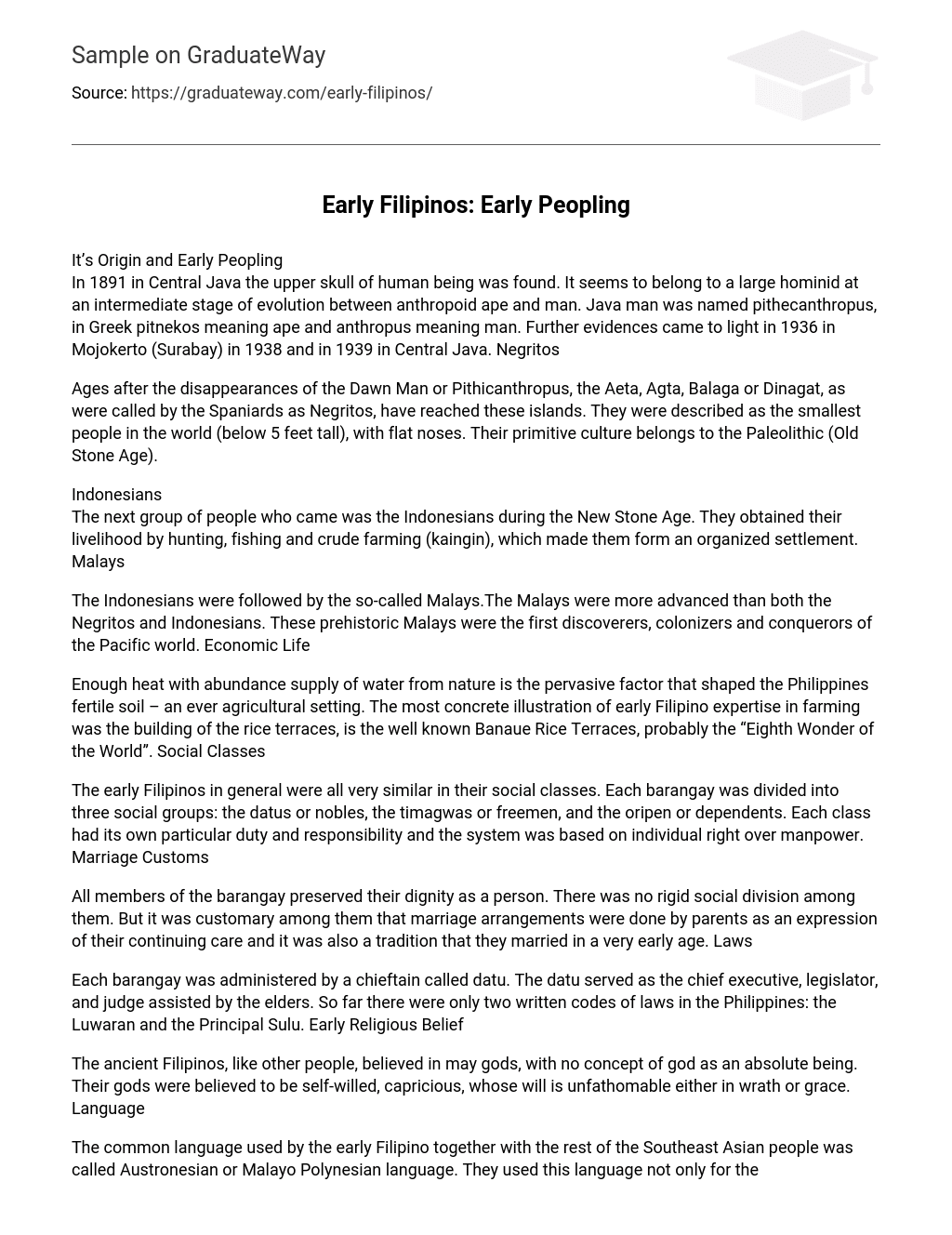It’s Origin and Early Peopling
In 1891 in Central Java, a large hominid skull was discovered, believed to be at an intermediate stage of evolution between anthropoid ape and man. This hominid was named Java man or pithecanthropus, derived from the Greek words pitnekos meaning ape and anthropus meaning man. Additional evidence of early peopling was unearthed in Mojokerto (Surabay) in 1936, as well as in 1938 and 1939 in Central Java. These findings shed light on the presence of early human populations. Negritos
The Negritos, also referred to as Aeta, Agta, Balaga, or Dinagat by the Spaniards, arrived on these islands long after the Dawn Man or Pithicanthropus vanished. They were categorized as the smallest people globally, with a height of less than 5 feet and flat noses. Their culture falls under the Paleolithic era (Old Stone Age).
Indonesians, the next group of people to arrive during the New Stone Age, relied on hunting, fishing, and crude farming (kaingin) for their livelihood. These activities led them to establish an organized settlement. Also present were Malays.
The Negritos were followed by the Indonesians, who in turn were followed by the so-called Malays. The Malays were more developed than both the Negritos and Indonesians. These ancient Malays were the original explorers, settlers, and rulers of the Pacific region. Economic Life
The Philippines’ fertile soil is predominantly shaped by ample heat and an abundance of water from nature, creating an agricultural environment. The impressive Banaue Rice Terraces, often referred to as the “Eighth Wonder of the World,” showcase early Filipino expertise in farming. Additionally, social classes were evident in this agricultural setting.
The social classes among the early Filipinos were uniform. Each barangay had three social groups: the datus or nobles, the timagwas or freemen, and the oripen or dependents. Each class had its specific duties and responsibilities, and the system operated on the principle of individual control over manpower. Marriage customs were also observed.
All members of the barangay maintained their personal dignity and there was no strict social hierarchy among them. Nevertheless, it was a common practice for parents to arrange marriages as a means of expressing their continued concern, and marrying at an early age was also customary. Laws
Each barangay was governed by a chieftain known as a datu, who held the positions of chief executive, legislator, and judge, with assistance from the elders. At that time, the Philippines had two written codes of laws: the Luwaran and the Principal Sulu. Early religious beliefs were also prevalent.
The ancient Filipinos shared the belief in multiple gods, similar to other societies, without a understanding of a singular, all-powerful deity. They viewed their gods as independent entities with unpredictable and incomprehensible natures, capable of both anger and benevolence. Language
The early Filipinos, along with the rest of the Southeast Asian people, used a language called Austronesian or Malayo Polynesian language. This language served as their common means of communication for daily conversations and foreign trade and commerce. Education
The early Filipino children received their education from their parents and elders in the barangay, who served as their teachers. In panay, the usual barangay school was referred to as bothoan. The curriculum included instruction in reading, writing, and arithmetic, commonly known as the 3 R’s. Additionally, subjects such as sciences and calendar were also taught.
The ancient Filipinos possessed their own understanding of mathematics and geometry, which they applied not only in trade but also in constructing the vast rice terraces. They were capable of counting up to 100,000,000.
The Ifugaos utilized a calendar to ascertain the duration of days, months, and years, specifically for their agricultural practices of planting and harvesting.





